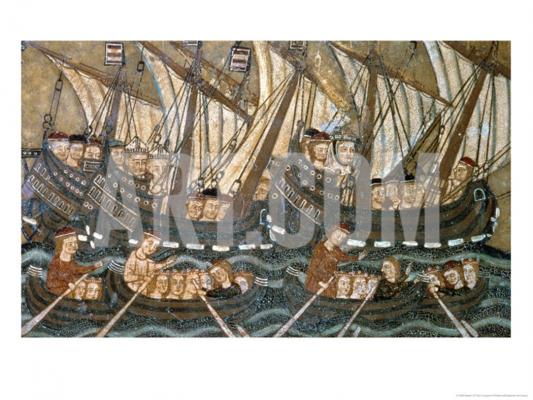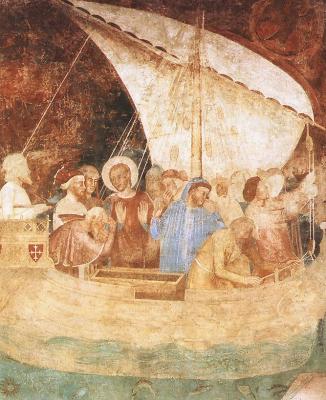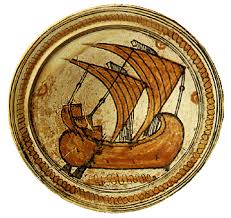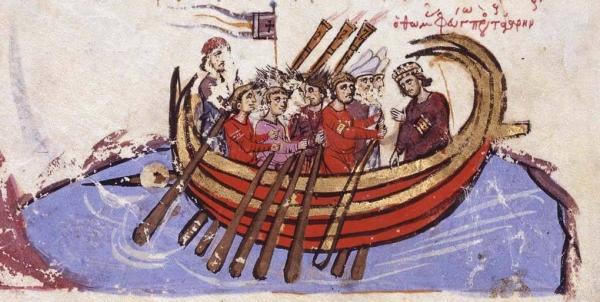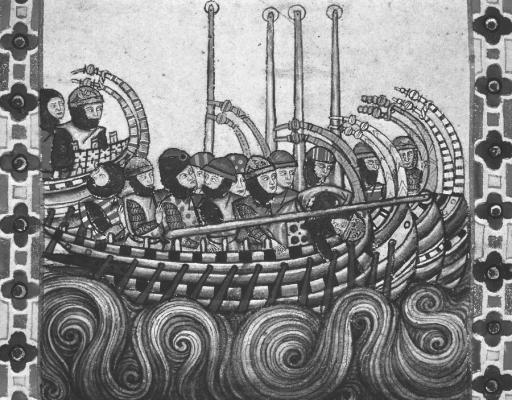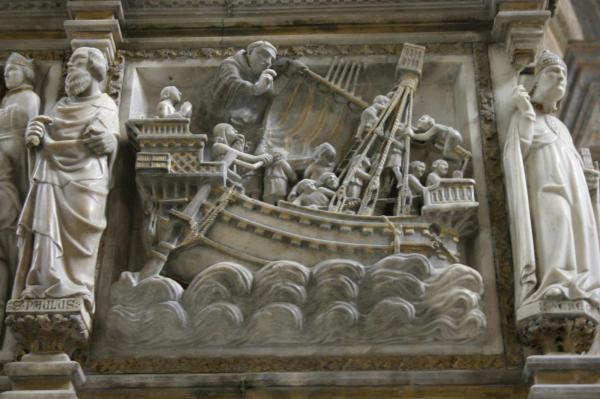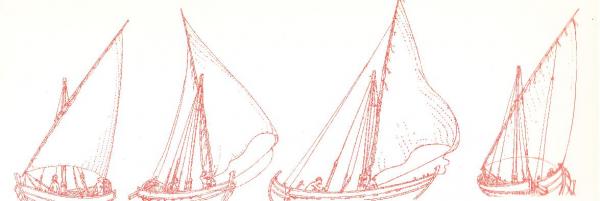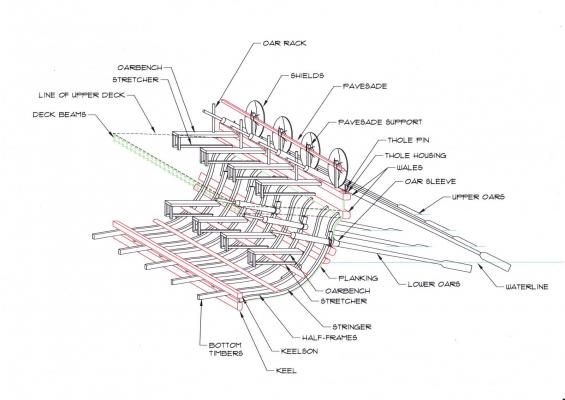-
Posts
7,987 -
Joined
-
Last visited
Content Type
Profiles
Forums
Gallery
Events
Everything posted by Louie da fly
-
Moving a workshop is a large operation. No wonder we haven't heard from you lately. The mast issue is certainly a bit of a puzzle. I looked at it when I was making my Great Harry many years ago, but ended up just making a single-piece mainmast. If I did it today I'd probably want to go with multi-piece, but I have no more idea than you of how to do it. The dromon design is going slowly. I've pretty much given up on the cross-section, and I'm working on redesigning the full vessel in accordance with the Yenikapi discoveries in Istanbul. The problem is when you change one thing, everything else is affected. Changing the shape of the section affects the height of the waterline, which affects the position of the lower bank of oarsmen, which in turn affects the height of the upper bank, which then affects the height of the midships castle . . . and I’ve recently got a new job which involves using AutoCad eight hours a day designing houses, so when I get home it’s a bit hard forcing myself to the computer to open up AutoCad to work on a ship design . . . I’ll get there eventually, but it does rather stretch things out. I’m going to add an update to my dromon thread to show how things are going. Steven
-
Dick, I realised I hadn't complimented you on the most recent pictures of the nave tonda. She looks magnificent. Haven't heard from you for awhile. Are you still working on the ship? I just came across a good picture showing a careened carrack in Carpaccio's Meeting of the betrothed from the St Ursula cycle. Zoomed up to full size it loses a bit of detail, but it's pretty damn good. It's at https://commons.wikimedia.org/wiki/Category:Departure_of_the_Pilgrims_by_Carpaccio then you click on the picture for a huge copy of it. And I just noticed, at the bottom of the same page there are thumbnails of other details of the same picture showing not only a much better detail of the same carrack, but very good detailed pics of the other carracks in the same harbour, and two others I'd never seen, apparently in dry dock, from the left hand side of the painting. The careened carrack's rigging, and the way it's being held in place, are also very interesting. Right down the bottom of the page are links to the other paintings in the Ursula cycle, some of which have exceptionally detailed representations of ships. Best wishes, Steven
-
Thanks, Dick. I'll try following up on these. I've got Landstrom's book and I've been looking at his illustrations and text. I'll see what I can do about the others. I think in general I've now got a reasonable understanding of how this rig worked and what it was made up of, which I certainly didn't have before. But I'll probably learn more as I start building. Steven
-
Some more mediaeval pictures of ships with lateen sails. The first is Catalan, thought to be from the mid-late 13th century (maybe about 1290) and shows quite a bit of detail - shrouds, halyards, braces and perhaps a fore-tackle, plus what may be a parrel truck fixing the yard to the mast - or perhaps just a loop of rope (sorry about the watermark - this is the biggest representation I could find on the net). The next is mid-14th century Italian and shows most of the ropes and blocks. The fore-tackle is particularly clear. The next is Byzantine, from about 1200 AD and again shows shrouds, tackles and braces. The detail's not as good, as the picture's so small. The fourth picture is 14th century Spanish. It shows a single brace and fore-tackle, and halyards, but no shrouds. The yard seems to be held to the mast with a double loop of rope. But a picture's emerging which should allow me to produce a rig which I'm confident is close to what was in use at the time. There seem to have been variations, as one would expect - the fixing of the shrouds to the mast, the suspension of the yard, either by a loop of rope, or two loops. I've also come across pictures of lateeners with parrels, but I don't seem to have taken copies (damn!). Though I'd expect larger ships to use parrels, I haven't got any hard evidence for them in the right period, so I probably won't have them on the model. There seems to be no sign of lifts for the yard at this time, and it's perhaps debatable whether they could have been used, as the yard seems almost always to have been hoisted all the way to the top of the mast. Also, a picture by a Byzantine artist of a galley which appears to me to have a horizontal spur at the bow, just as I proposed in my last post. Unfortunately I don't know the source, but it looks to be from some time in the 12th century AD. The artist seems to have got the direction of the oarsmen wrong - they should be facing the stern, which is where the steersman is. And finally, a Spanish picture from between 1270 and 1284 which shows a galley in the foreground with what appears to be a lowered mast (almost horizontal, in front of the soldiers). The ships in the background still have their masts vertical. The "wings" of the ship are at the stern, so the mast is leaning aftwards. If this really is a mast, I may have been wrong in thinking the masts were pulled out of the deck with sheers - I may have to go back to the idea of a pivoting mast. Of course, it's possible that what we see here is not a lowered mast but a broken one - the lower end does look like it may have been broken off. Aha! I've found the other picture of the tops of shrouds wrapped around the mast - it's early 15th century, a galley from Michael of Rhodes' treatise on shipbuilding. See the final picture. It's also got some very good details of rigging, though I have to say it's rather late - up to 400 years after the time I'm interested in, and a lot of evolution would have happened in ship design in the meantime. Steven
-
Here are the two earliest representations I can find of mediaeval lateen rigging that show any detail at all. The earlier one is 9th century AD Byzantine and is fairly simple, but it does show the shrouds and the fore tackles for the yard, as well as what appears to be a halyard with a block. The rudder's also very interesting - it appears to be attached to a platform. The other is from 1339 and is Italian, and has a LOT of detail, including not only the shrouds but their method of fastening -not deadeyes but blocks [edit - this is so the shrouds on the lee side of the ship could be slackened off when tacking, so they didn't keep the sail from filling with wind to its fullest extent - see attached picture] - a rope ladder to the top, fore tackles, bolt ropes and even the shape of the tiller and the tackles that hold the rudder in position, one fore and one aft. It also shows the shape of the top and apparently how the shrouds are fixed to the mast (wrapped around) - I have no idea if this was common practice in the Middle Ages, but it's certainly different from later practice [edit - I've since found at least one other representation of the tops of the shrouds wrapped around the mast just under the top]. The other details of the ship of course have very little to do with a dromon - totally different type of ship, and several centuries too late. But one question - what are those ropes halfway along the yard that seem to lead upwards to heaven?
-
Ben, there are a bunch of images of rams from archaeological finds here. You might find them of use in making your spikes. Steven
-
Sherry, that's an exquisite model. You've set the bar very high for the rest of us duffers (well, me, anyway - from what I've seen there are so many amazingly skilled, patient and painstaking modellers out there in MSW land that I sometimes wonder if my own efforts will be up to the mark. Still, one can but try). Steven
-
I’ve changed my mind about the midships section – I’m just going to build a “bog basic” section to see if the two banks of oars work together without fouling each other. If so, I can go on with the full dromon with a clear conscience. I may at some future date build the section as well, but I think at the moment doing something that complex is just a distraction from ever starting on the full ship, which is what I intended to do in the first place. I’m having to re-investigate the layout of the ship and may have to re-draw it almost completely, due to the information uncovered by the discoveries at Yenikapi. Though in general these confirm the theoretical reconstruction in Age of the Dromon, there are several important differences between it and the galeai found in Istanbul. Firstly, the reconstruction has the oarports approximately 300mm (1 foot) higher and 300mm forward of the front of the oarbenches. In the only Yenikapi ship (a single-banked galea) with a surviving oarport strake these distances are 400mm and 450-480mm. The discrepancy of height would mean the oars would have to be longer and would reach the water further away from the ship. However, while a dromon has two banks of oars a galea has only one, so the Yenikapi galley had no problems with interference between banks. The nearer the oars are to horizontal to the water surface, the better the mechanical advantage. However, I believe the reconstruction’s oar height is probably closer to the truth, as the shipbuilders would have traded off mechanical advantage against oar-length and height of the upper bank. If a dromon’s lower oars were as long as on a galea, the upper oars would have to be unmanageably long to miss them. And another 100mm (4”) in height would make the dromon that much higher and less stable, and add unnecessary weight. The discrepancy of horizontal offset would mean the oarsmen would have to stretch further to pull on the oars. Without trying this out I don’t know if an extra 150-180mm of reach would be harder on the oarsmen, but as this is something that would have been arrived at after centuries of experiment, I feel it’s likely to be right. Also it appears I've got the midships cross-sectional shape wrong, so I'll have to look at that again and see what I can come up with. I originally believed the mast would have been permanently set in the mast-step, and pivoted above the deck to lower it for battle. However, on consideration I’ve come to agree with Professor Pryor’s evaluation, that it would have been able to be pulled out with sheers. The masts are fairly light (I worked out a rough estimate based on their length and diameter and the density of the wood likely to have been used), so a reasonably small number of mariners should be able to achieve this. The mediaeval sources describe supports for both the masts and the yards when not in use – they have different names and are almost certainly different pieces of equipment. I have to work out how they would have related to each other on the upper deck. As the yards would be lowered first, I expect the yard supports would be lower, and then the masts lowered onto a somewhat higher set of supports. The sources also describe what appear from the description to be catheads – at the bow, and the anchor hangs from them – though exactly what form they’d take I don’t know. Would they be like later catheads, or would they be very different? Would they have sheaves? I think to do a similar job they’d probably have to be fairly similar in form, but that’s just another of the guesses I have to make in designing this model . On the foredeck the ship will need a windlass, a ballista and a siphon for Greek Fire.The sides of the hull near the nozzle had metal plates to protect the timbers. Greek Fire needed favourable conditions – no wind, or a gentle breeze blowing toward the enemy. Otherwise it wouldn’t work, or would be a danger to the operator. It would be nice to have a working Greek Fire unit, but I think that may be a bit foolhardy. I don’t want to set fire to my model by mistake. The spur was mounted at the bow and was apparently used to smash the enemy’s oars –the ram seems to have vanished several centuries earlier as framed ships were too strong to be sunk by ramming. The design in Age of the Dromon shows a spur coming up diagonally from near the waterline, with a chain or perhaps a metal brace supporting it. But this design seems to be based on a picture of dromon from several centuries before, where the spur appears to be built into the hull like a ram. By the time of my own model the spur was removeable, with an iron fitting holding it in place. If so, ramming would impose considerable torque on the spur, which would tend to pivot around the fitting holding it to the hull, and perhaps seriously damage the ship. I believe the spur should be in line with the force of collision (i.e. horizontal) and would probably fit into a socket in the hull, which is possibly where the “fitting” comes in. I’ve put arched supports for the xylokastron (central castle) – not for any reason other than that the ship is Byzantine and they went in for arches in a big way. As a dromon was the prestigious line-of-battle ship of the time, (the Yenikapi galleys, as Imperial navy ships, were all built of high quality timbers, unlike the merchant ships found in the same site which seemed to be cobbled together from whatever came to hand), I think a bit of ostentation would not be out of place. I’ll need to do some research further down the track about lateen rigging – I really don’t know much about it, and it’s complicated by the fact that there’s pretty much no reliable information about 11th century Mediterranean lateen rig. Is it the same as later European lateen rigging or is it very different? Some blocks and toggles have been found, and a paper is being written at the moment reconstructing the likely rigging of ships of this time, but it’s not likely to be ready for quite a few years yet. There’s only a fairly narrow access between the oarbenches of the upper deck, and I’ve had a bit of trouble working out where to put the companionway down to the lower deck. I think the most likely place is right by the central mast, but I can’t be certain I’m right. It’s not known for sure how orders were relayed from the captain to the oarsmen, and the lower oarsmen would certainly not be able to hear them directly. On Olympias they used a loudspeaker, but nobody knows what was done at the time. It is recorded that the notes of a flute gave the time to the oarsmen, and perhaps also other commands. Apparently a high-pitched tone carries well among the sounds of a galley under way. However, the sources say this was not done when the ship was going into battle, but they don’t say what method was used. Perhaps messengers sent down to the lower deck to the officers in charge there? Perhaps they used a system of hand signals? Dromons (and all galleys of this type) were poor sailers – their freeboard was so low – a 10 degree heel would put the oarports under the water - and they were so prone to capsize, that they could really only sail before the wind. I think it’s likely that with a following wind the lateen sails of the two masts would have been spread one either side of the centre line, to even up the forces. According to dendrochronology, the galea wreck known as YK4 was perhaps 200 years old when it sank, which is a surprising age for a vessel of this type. It had been repeatedly repaired with different timbers than the ones it had been built from. Hogging was avoided by use of several heavy wales approximately 150x150mm (6”x6”) in cross-section running fore and aft, and all the vessels but YK4 also had stringers running fore and aft fixed to the top of the bottom timbers. A dromon would also have been stiffened by the planking of the upper deck. One problem that hasn’t yet been solved is how enough air got to the lower oarsmen for them to work efficiently. A fully decked vessel just doesn’t have enough airflow. Perhaps the deck was made of gratings, and perhaps there was some kind of lattice construction between the wales above the lower oarport strake. Nobody knows. The performance of a dromon is unknown. The Olympias, a reconstruction of an Ancient Greek trireme, was capable of 7 knots and it’s thought if another one was built today using the lessons learnt from the first it could go even faster. Olympias is capable, at full speed, of turning in twice its own length, an impressive feat. I doubt a dromon could achieve this performance, but it was the racehorse of its day. It was superseded by the more efficient Western European galea (not the same as the Yenikapi galea, from which it got its name), which rowed two banks of oars from a single set of benches. It was lighter and faster than the dromon, and edged it out in little more than a century. To my surprise I discovered that side rudders (steering oars) are more efficient than a stern rudder is. There’s a fascinating paper by Lawrence Mott on the development of the rudder from 100 to 1600 AD at http://nautarch.tamu.edu/pdf-files/Mott-MA1991.pdf which goes over this in great detail. Well worth a read. The only reason I can think of that the stern rudder would have replaced the side rudder is the increasing size of ships which would have needed a steering oar so big it was impossible to handle. Most Mediterranean ships of the time had two steering oars, which could be raised and lowered independently of each other, so the ship could proceed with a single rudder if needed (there were times when this was a better option). They needed to be held down or they’d float upwards out of their proper position. They could also be raised right out of the water when (as was usual with galleys) the ship was beached overnight, aft-first. As I mentioned before I worked out a rack system to hold the upper oars for when the ship went into battle. Each upper oar is a little over 5 metres long and the distance between the oarbenches is a little under a metre. So at any one point there are 5 oars in the rack. It seems to me that placing the oars in the rack would have to be done very systematically, otherwise chaos would ensue, with oars getting mixed up and impossible to extricate later. I think they’d have to be laid “spoon-fashion”, probably starting with the bow-most oar and working down the side of the ship. Picking them up would be done in reverse order. Olympias showed it was vital for oarsmen to take their seats in the proper order, especially for the lower decks, and the same should apply for a dromon. Pulling the lower oars inboard (say when coming alongside an enemy vessel to board) should be reasonably ok – I worked out if you pull the oar inboard on a diagonal there should be room – but there might be problems with the foremost and aftermost oars. Getting the oars below decks down the companionway might also be a problem . There appear to have been two major forms of tactics – starting with a crescent-shaped line abreast facing the enemy, the idea was either to break the centre of the enemy line or to go around the end of their line and attack from the stern. Either way, the idea was to break up their formation and the battle apparently then degenerated into a melee of individual ships. However, as with everything else, the information is so scarce that nobody really knows. It was advised to fight near land – but not your own territory, as the proximity of friendly land made desertion more likely. I’ve worked out that the deck beams need some kind of support part way along their length, as timbers that could cover 4 metres in a single span would have to be far too heavy for a ship of this size. However, a central beam, or perhaps two beams equally spaced, running fore and aft under the deck beams would do the job. Vertical struts at intervals, supported by the ship’s frames or keel would hold up the fore and aft beams. It would be preferable to have two beams, to avoid a line of vertical struts running down the centre of the ship obstructing movement. But if there were two they’d have to be positioned so the struts didn’t get in the way of the oarsmen when they were rowing. Well, that’s the current state of play. I’m looking forward to getting started, but I think it’s going to be a while yet. Steven
-
Yes, unfortunately the information about the patterns and colours on Viking shields is very thin on the ground, as so few shields have bee recovered. Even the colours on the Gokstad shields have now vanished, as the science of archaeological conservation was only in its infancy when the ship was discovered over 100 years ago. And even then, the Gokstad ship was apparently a pleasure vessel rather than a warship, and as far as I know it's the only one that's ever been found with shields along the sides. So did warships have them? Not sure - perhaps the sagas mention them, but even the sagas weren't written down till centuries after the Viking period. The Bayeux Tapestry shows William the Conqueror's ships with shields along the sides, and some contemporary images of Viking ships (at https://www.google.com.au/search?q=viking+ships&espv=2&biw=1280&bih=685&tbm=isch&tbo=u&source=univ&sa=X&ei=cshqVeizJ4_m8AWp7oPIAw ) have them. Really, your guess is as good as anyone else's. All you can do is look at the available evidence and judge for yourself what's right to put on your ship. At least if you do that, nobody can tell you you're wrong . . . Best wishes, Steven
-
Jerry, you can find probably the definitive information about the patterns on Viking shields at http://members.ozemail.com.au/~chrisandpeter/shield/shield.html The Gokstad ship's shields were alternating solid yellow and black - i.e each second shield was either yellow or black. The main site this comes from is http://members.ozemail.com.au/~chrisandpeter/and has a lot of stuff on the Vikings which might be of help to you. Regarding the rigging of Viking ships, nobody knows for certain, as all that's been found are various wooden artefacts which are probably blocks, and some which MIGHT be deadeyes. Nothing was found in position, no ropes, no sails. Contemporary pictures also give some indication, but it's really only conjecture and best guess as to what the rigging layout really was. There have been quite a number of reconstructed Viking ships built and sailed, and it's possible a lot was learnt from them as to what is a workable rigging plan based on what was found in the ground. But it's still only educated guesswork. Steven
-
There are also many other ancient Greek sources, such as the Odyssey and perhaps the Iliad, as well as Thukydides (is that spelled right?) and other contemporary historians. Even with the fictional stories such as the Jason and the Argonuts, and the Odyssey, the author was writing for an audience who knew whether people wrote names on their ships, carried shields on board etc, so the information would probably be fairly reliable. You may find also that if you contact the people who built the Argo reconstruction they might be able to help you. I think the article I linked to in my last post contains a contact section. Steven
-
Pasanax, have you seen the Youtube video at https://www.youtube.com/watch?v=-s_0bwC7Hi8 of the reconstruction and sailing trip of Jason's 50-oared Argo? There's an article about her at http://www.argonautes2008.gr/en/argo-ship/new-argo-ship.html The reconstruction looks very good to me - the construction method is correct, using tenons between the planks, so I think the research for her shape and layout was probably also correct. I don't know the answers o the questions in your first post, but I've never herd of a drum being used on a Greek galley. I expect the oarsmen would have had spears and shields, though I don't remember seeing them on any contemporary pictures of the ships, so perhaps they were stored out of sight somewhere. I've also never heard of an ancient Greek galley's name being written anywhere on the ship - you might try reading such things as the story of Jason and the Argonauts and historical descriptions of voyages to see if it's mentioned. If not, I think you're safe leaving it off. Best wishes, Steven
-
Well, here's the amended drawing of the midships section. I've exaggerated the distance between the frames for clarity - with this you can see the alternating bottom timbers and half-frames. I haven't yet sorted out some of the issues, such as how the lower benches are supported at the inboard end - the outboard end is set into a mortise in the wale, and the inboard end of the upper ones rests on the deck, but I have to work out how to support the ower ones - presumably they'll be supported by the frames. I'm pretty happy with this layout, and I'll probably also see if I can find space to fit such items as water barrels (galley crews needed a LOT of water) within the hull. Prof Pryor's book shows possible places to store stuff, and I have the opportunity to test the theory out in the real world. The house renovations are nearly complete. I'm hoping that will give me the opportunity to get something started fairly soon - but of course life often gets in the way, so we'll just have to see how it goes. Steven
-
Ben, I just caught your video. That's totally amazing! Such maneuvrability! Much better than the previous videos I've seen of model galleys in action. I take my hat off to you, sir. Stven
-
Curioser and curioser - On re-reading the archaeological report of the Yenikapi galleys, I've discovered I'll have to amend my cross-section drawing yet again. It seems the frames in mediaeval (and earlier) Mediterranean ships in general, and in the Yenikapi galleys in particular, followed a . . pattern of alternating floor timbers and paired half-frames . . . Floor timbers span the bottom of the ship, with their extremities extending just to the turn of the bilge [on each side of the ship]; in contrast, half-fames span the width of the keel and extend up one side of the ship, through the turn of the bilge to, or just beyond, the first wale . . . At each frame station, floor timbers and half-frames are paired with futtocks placed adjacent to, but not fastened to, the floor timber or half-frame, with ends overlapping by the width of one or more planks. The bit in square brackets is my addition, to clarify that the floor timbers reach right across the bottom of the ship, from side to side. I can't do it at the moment, but I'll amend the drawing to reflect this framing pattern when I get the chance. Steven
-
I just came across a very interesting video on Youtube of a reconstruction of Jason's Argo under construction and then in action. Shows the "shell-only" (i.e. frameless) construction of the ship, using coaks between the planks - see https://www.youtube.com/watch?v=-s_0bwC7Hi8 Steven
-
I just came across a very interesting video on Youtube of a reconstruction of Jason's Argo under construction and then in action. Shows the "shell-only" (i.e. frameless) construction of the ship, using coaks between the planks - see https://www.youtube.com/watch?v=-s_0bwC7Hi8 Steven
-
Yes indeed, Ben. In fact Fitch ran the first steam powered passenger service up and down the Hudson River for a considerable time and had a long-running battle with Fulton (of Clermont fame) as to who had the right to do so, and who had stolen the idea of the steamboat from whom. He used lever-driven paddles because Benjamin Franklin had told him paddle-wheels were never going to work. Fulton won in the end, but I have a lot of sympathy for Fitch - an original mind, but with the odds stacked against him because of his origins and lack of education. I found about him from a book called Steam by Andrea Sutcliffe, which my son gave me for a birthday present. It's fascinating, and I'm very grateful to him for it.
About us
Modelshipworld - Advancing Ship Modeling through Research
SSL Secured
Your security is important for us so this Website is SSL-Secured
NRG Mailing Address
Nautical Research Guild
237 South Lincoln Street
Westmont IL, 60559-1917
Model Ship World ® and the MSW logo are Registered Trademarks, and belong to the Nautical Research Guild (United States Patent and Trademark Office: No. 6,929,264 & No. 6,929,274, registered Dec. 20, 2022)
Helpful Links
About the NRG
If you enjoy building ship models that are historically accurate as well as beautiful, then The Nautical Research Guild (NRG) is just right for you.
The Guild is a non-profit educational organization whose mission is to “Advance Ship Modeling Through Research”. We provide support to our members in their efforts to raise the quality of their model ships.
The Nautical Research Guild has published our world-renowned quarterly magazine, The Nautical Research Journal, since 1955. The pages of the Journal are full of articles by accomplished ship modelers who show you how they create those exquisite details on their models, and by maritime historians who show you the correct details to build. The Journal is available in both print and digital editions. Go to the NRG web site (www.thenrg.org) to download a complimentary digital copy of the Journal. The NRG also publishes plan sets, books and compilations of back issues of the Journal and the former Ships in Scale and Model Ship Builder magazines.




